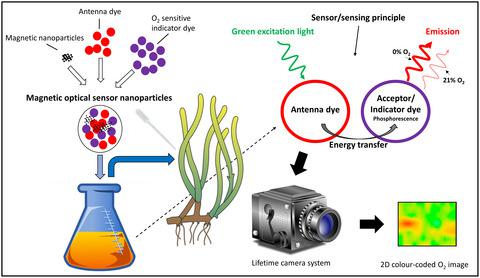Our official English website, www.x-mol.net, welcomes your feedback! (Note: you will need to create a separate account there.)
Imaging O2 dynamics and microenvironments in the seagrass leaf phyllosphere with magnetic optical sensor nanoparticles
The Plant Journal ( IF 7.2 ) Pub Date : 2020-10-09 , DOI: 10.1111/tpj.15017 Kasper Elgetti Brodersen 1 , Michael Kühl 1 , Erik Trampe 1 , Klaus Koren 1, 2
The Plant Journal ( IF 7.2 ) Pub Date : 2020-10-09 , DOI: 10.1111/tpj.15017 Kasper Elgetti Brodersen 1 , Michael Kühl 1 , Erik Trampe 1 , Klaus Koren 1, 2
Affiliation

|
Eutrophication leads to epiphyte blooms on seagrass leaves that strongly affect plant health, yet the actual mechanisms of such epiphyte‐induced plant stress remain poorly understood. We used magnetic optical sensor nanoparticles in combination with luminescence lifetime imaging to map the O2 concentration and dynamics in the heterogeneous seagrass phyllosphere under changing light conditions. By incorporating magnetite into the sensor nanoparticles, it was possible to image the spatial O2 distribution under flow over seagrass leaf segments in the presence of a strong magnetic field. Local microniches with low leaf surface O2 concentrations were found under thick epiphytic biofilms, often leading to anoxic microhabitats in darkness. High irradiance led to O2 supersaturation across most of the seagrass phyllosphere, whereas leaf microenvironments with reduced O2 conditions were found under epiphytic biofilms at low irradiance, probably driven by self‐shading. Horizontal micro‐profiles extracted from the O2 images revealed pronounced heterogeneities in local O2 concentration over the base of the epiphytic biofilm, with up to 52% reduction in O2 concentrations in areas with relatively thick (>2 mm), compared with thin (≤1 mm), epiphyte layers in darkness. We also present evidence of enhanced relative internal O2 transport within leaves with epiphyte overgrowth, compared with bare seagrass leaves, in light as a result of limited mass transfer across thick outward diffusion pathways. The local availability of O2 was still markedly reduced in the epiphyte‐covered leaves, however. The leaf phyllosphere is thus characterized by a complex microlandscape of O2 availability that strongly affects microbial processes occurring within the epiphytic biofilm, which may have implications for seagrass health, as anoxic microhabitats have been shown to promote the microbiological production of reduced toxic compounds, such as nitric oxide.
中文翻译:

用磁性光学传感器纳米颗粒成像海藻叶球体中的氧气动力学和微环境
富营养化导致海草叶子上的附生植物大量开花,这严重影响了植物的健康,但是这种由附生植物引起的植物胁迫的实际机制仍然鲜为人知。我们将磁性光学传感器纳米颗粒与发光寿命成像结合使用,以绘制变化的光照条件下非均质海草叶球层中O 2的浓度和动力学。通过将磁铁矿掺入传感器纳米颗粒中,可以在强磁场存在下成像流过海草叶片段的空间O 2分布。在厚厚的附生生物膜下发现了叶片表面O 2浓度低的局部微生态位,通常导致在黑暗中缺氧的微生境。高辐照度导致O在大部分海草叶脉中都出现过饱和2,而在附生生物膜下低辐照度下发现的O 2条件降低的叶片微环境,可能是由于自身阴影的驱动。从O 2图像中提取的水平微观剖面显示,附生生物膜底部的局部O 2浓度具有明显的异质性,与较薄的区域相比,较厚的区域(> 2 mm)的O 2浓度降低了52%。(≤1mm),附生植物层在黑暗中。我们还提供了增强的相对内部O 2的证据与光生的海草叶相比,附生植物过度生长的叶片中的叶绿素运输在光中是由于穿过厚厚的向外扩散途径的有限质量转移的结果。但是,在附生植物覆盖的叶子中,O 2的局部可用性仍然显着降低。因此,叶系球层的特征在于复杂的O 2可利用性微景观,该景观严重影响附生生物膜内发生的微生物过程,这可能对海草健康产生影响,因为已证明缺氧微生境可促进微生物产生减少毒性化合物,例如一氧化氮。
更新日期:2020-10-09
中文翻译:

用磁性光学传感器纳米颗粒成像海藻叶球体中的氧气动力学和微环境
富营养化导致海草叶子上的附生植物大量开花,这严重影响了植物的健康,但是这种由附生植物引起的植物胁迫的实际机制仍然鲜为人知。我们将磁性光学传感器纳米颗粒与发光寿命成像结合使用,以绘制变化的光照条件下非均质海草叶球层中O 2的浓度和动力学。通过将磁铁矿掺入传感器纳米颗粒中,可以在强磁场存在下成像流过海草叶片段的空间O 2分布。在厚厚的附生生物膜下发现了叶片表面O 2浓度低的局部微生态位,通常导致在黑暗中缺氧的微生境。高辐照度导致O在大部分海草叶脉中都出现过饱和2,而在附生生物膜下低辐照度下发现的O 2条件降低的叶片微环境,可能是由于自身阴影的驱动。从O 2图像中提取的水平微观剖面显示,附生生物膜底部的局部O 2浓度具有明显的异质性,与较薄的区域相比,较厚的区域(> 2 mm)的O 2浓度降低了52%。(≤1mm),附生植物层在黑暗中。我们还提供了增强的相对内部O 2的证据与光生的海草叶相比,附生植物过度生长的叶片中的叶绿素运输在光中是由于穿过厚厚的向外扩散途径的有限质量转移的结果。但是,在附生植物覆盖的叶子中,O 2的局部可用性仍然显着降低。因此,叶系球层的特征在于复杂的O 2可利用性微景观,该景观严重影响附生生物膜内发生的微生物过程,这可能对海草健康产生影响,因为已证明缺氧微生境可促进微生物产生减少毒性化合物,例如一氧化氮。



























 京公网安备 11010802027423号
京公网安备 11010802027423号